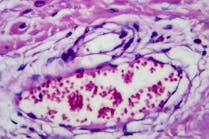Fresh discoveries about a type of immune cells could give lung cancer patients a more accurate prognosis and better identify who will benefit from immunotherapies.
Researchers found that the location in and around tumors of cytotoxic T cells, which play a key role in fighting cancer, may help predict patient survival and indicate whether or not treatments will work.
For this Cancer Research UK-funded study, University of Edinburgh researchers investigated why immunotherapy fails so often against the disease by examining molecules that can interfere with the activity of T cells, a type of white blood cell that fights disease.
The team examined tumor tissue from 162 patients undergoing surgery for non-small cell lung cancer (NSCLC), the most common type, which accounts for more than 80 percent of lung cancer cases.
The results revealed that high levels of two enzymes (CD39 and CD73), found on the surface of many different types of immune cells, were associated with reduced patient survival if found in tissue near the tumors.
The team also found that both the location and types of T cells that express these enzymes could also play an important role in helping to predict a patient’s prognosis and the success of immunotherapy.
High levels of CD39 on the surface of cytotoxic T cells located inside tumor nests – clusters of cancer cells - were associated with increased patient survival and a better response to immunotherapy.
In contrast when the same CD39 cytotoxic T cells were found outside of these tumor nests, in a region called the stroma, they did not affect patient survival.
High levels of CD39 on the surface of another type of T cell, known as regulatory T cells, that normally prevent the immune system from becoming overactive, were associated with reduced survival.
The findings were consistent even when other factors were taken into consideration – such as a patient’s age, tumor size and whether they received chemotherapy in addition to surgery.





